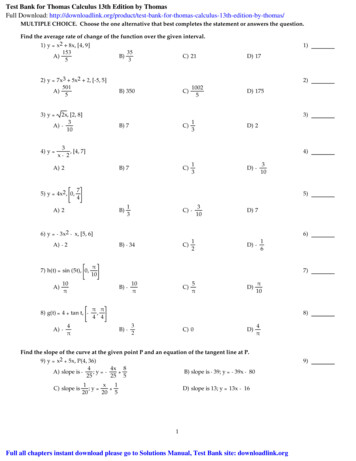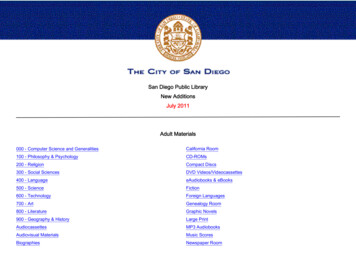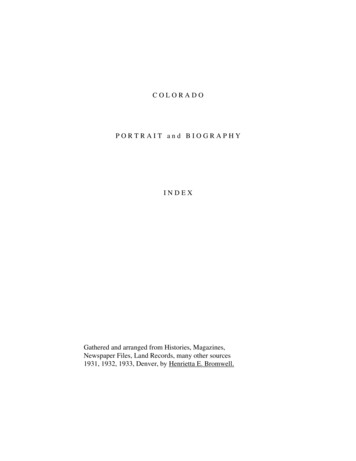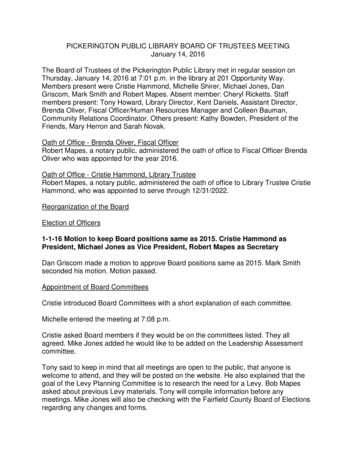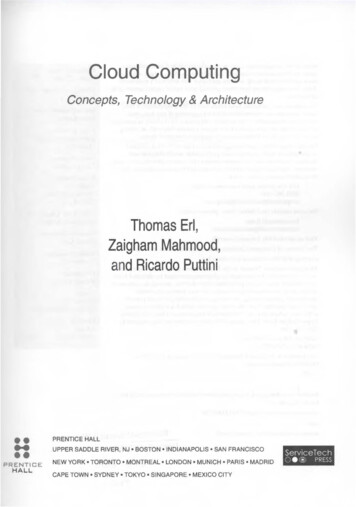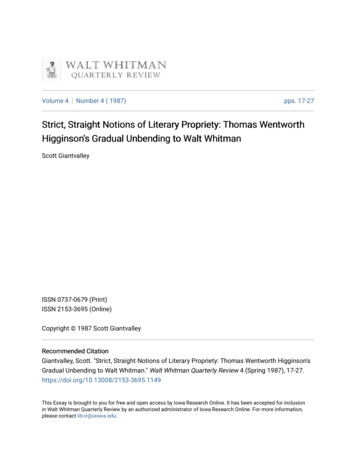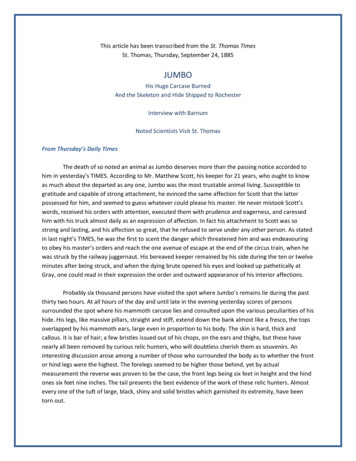
Transcription
This article has been transcribed from the St. Thomas TimesSt. Thomas, Thursday, September 24, 1885JUMBOHis Huge Carcase BurnedAnd the Skeleton and Hide Shipped to RochesterInterview with BarnumNoted Scientists Visit St. ThomasFrom Thursday’s Daily TimesThe death of so noted an animal as Jumbo deserves more than the passing notice accorded tohim in yesterday’s TIMES. According to Mr. Matthew Scott, his keeper for 21 years, who ought to knowas much about the departed as any one, Jumbo was the most trustable animal living. Susceptible togratitude and capable of strong attachment, he evinced the same affection for Scott that the latterpossessed for him, and seemed to guess whatever could please his master. He never mistook Scott’swords, received his orders with attention, executed them with prudence and eagerness, and caressedhim with his truck almost daily as an expression of affection. In fact his attachment to Scott was sostrong and lasting, and his affection so great, that he refused to serve under any other person. As statedin last night’s TIMES, he was the first to scent the danger which threatened him and was endeavouringto obey his master’s orders and reach the one avenue of escape at the end of the circus train, when hewas struck by the railway juggernaut. His bereaved keeper remained by his side during the ten or twelveminutes after being struck, and when the dying brute opened his eyes and looked up pathetically atGray, one could read in their expression the order and outward appearance of his interior affections.Probably six thousand persons have visited the spot where Jumbo’s remains lie during the pastthirty two hours. At all hours of the day and until late in the evening yesterday scores of personssurrounded the spot where his mammoth carcase lies and consulted upon the various peculiarities of hishide. His legs, like massive pillars, straight and stiff, extend down the bank almost like a fresco, the topsoverlapped by his mammoth ears, large even in proportion to his body. The skin is hard, thick andcallous. It is bar of hair; a few bristles issued out of his chops, on the ears and thighs, but these havenearly all been removed by curious relic hunters, who will doubtless cherish them as souvenirs. Aninteresting discussion arose among a number of those who surrounded the body as to whether the frontor hind legs were the highest. The forelegs seemed to be higher those behind, yet by actualmeasurement the reverse was proven to be the case, the front legs being six feet in height and the hindones six feet nine inches. The tail presents the best evidence of the work of these relic hunters. Almostevery one of the tuft of large, black, shiny and solid bristles which garnished its extremity, have beentorn out.
The contract between the Barnum CO. And the G.T.R. explicitly states that the railroad companywill not be responsible for any loss sustained through accident to a larger amount that 15,000. Severalofficials of the Engineering Dept., G.T.R., arrived this morning and are making a plan of the vicinity of theaccident.Arrival of the ScientistsProf. Ward, of Rochester, proprietor of Ward’s Natural Science Institution received orders fromP.T. Barnum to skin Jumbo and remove his bones. The hide will be stuffed at the Institute in Rochesterand afterwards forwarded to Tuft’s College in Boston, to which it has been presented by Mr. Barnum.The skeleton will be forwarded to the Smithsonian Institute at Washington and placed there among thenatural curiosities of the United States.Prof. Ward arrived this morning, accompanied by C.E. Kelly and Wm. Cutchley, taxidermists, ofRochester, and after procuring a staff of local butchers, set to work to remove his hide.Cremating the CarcaseAfter the flesh is removed from the carcase it will be burned, Medical Health Officer Tweedalehaving given orders to that effect this morning. It was originally intended to bury the meat, but this willnot be allowed. His funeral pyre will be built to-night, and all curiosity seekers who have not as yetsecured relics can obtain some of the ashes of the defunct king of the elephants. One ingenious youthcarried away with him this afternoon a piece of Jumbo’s trunk, and states that he purposes having thehide tanned and converted into a cover for a scrap-book.Boiling the HideAfter the removal of the hide it will be taken to Griffin’s pork factory and salted. One hundredpounds of rock elm and 10 lbs. Powered elm have been purchased to be used for the service.Barnum’s RegretP.T. Barnum received the news of the death of Jumbo while at breakfast in the Murray Hill Hotelat New York yesterday morning. Mr. Barnum was very much affected and said that Jumbo’s death endedthe enterprise of taking the show to Europe next year as had been intended. Jumbo died withoutprogeny, but a posthumous calf is expected in February, 1887, when the parturition period of twentytwo months will have ended his consort. Mr. Barnum valued Jumbo at 300,000 for exhibition andbreeding purposes, and will bring suit against the Grand Trunk Railway Company for damages in thatamount.
Mourning Over the Loss of JumboA London, Eng., despatch reads: - The morning papers contain column obituaries lamenting thedeath of Jumbo. The Telegraph over its report of the death and history of the famous elephant, displayslarge headlines reading “Sad End of Jumbo, Killed by a Collision with a Railroad Train.”His Affection for AliceWhen the news spread that Jumbo had been killed there was a universal expression of regret.Many a situation was yielded up the ghost, it is fairly safe to say, without awakening a tithe of theinterest and sorrow attending the taking of the huge elephant which Barnum carried away from thepeople of England. Across the water he was a household word, and his affections for his mate, Alice, wasfor many years a favourite theme with writers. The introduction of the young Londoners into the affairsof life was hardly deemed complete until he had ridden upon the back of Jumbo. He was not preciselythe lion of the Zoo, but he was the elephant par excellence, and there is none to take his place in docilityand brightness of intellect. The loss to Barnum is great, but greater still is the affliction to the youngchildren here, who had begun to extend to their huge pet much of the affection which was his happy lotin England.SKINNING JUMBOPrecisely at one o’clock Prof. Ward with his two assistants had a corps of city butchers, headedby Pete Peters and John McCollum, stood around the departed Jumbo to take off his skin and dissect outhis bones. The dead monster crew crowds to the last, and there were hundreds on the grounds to viewthe dead giant. It was supposed that exhibition would be free, but this was not the case. Someenterprising individual had secured the privilege of collection an admission free. Policemen were placedat suitable points to keep out the crowd, except at the field gate, where admittance was gained bypaying 5 cents. But notwithstanding the cordon of guards, several hundreds of children, who playedtruant for the day, managed to get within the enclosure without payment.Jumbo still lay on the side of the bank in an admirable position to be advantageously skinned.Two of his legs were so placed that they had him on the incline. The taxidermists and butchers cut downthe back and belly and took off half of the skin, then they unjointed the two legs which held him to thebank after which he war rolled over without difficulty and that part of the task was accomplished. Thework of dissecting the huge bones was more difficult and it required all of the ingenuity of Prof. Ward todevise means to handle the immense limbs and masses of muscle while this was being accomplished. Inaccordance with the order of Dr. Tweedale about four cords of wood were procured and the funeralpyre built. As we go to press the body of the great Jumbo lies on this alter and is slowly being reduceddust to dust, ashes to ashes. No other creature, human or brute ever had such a well attended funeraland no other will be remembered as long in the annals of the city.
NotesJumbo died on British soil.Memorial tablets of Jumbo are now on sale at TIMES office. Price 5c.Barnum intended making an European tour next season, but without Jumbo his show will be likeHamlet with the ghost left out.The loss of Jumbo will be felt keenly by W.W. Cole, the well-known circus owner, who only a fewweeks ago bought a one-third interest in the brute for dame rumor saith, 60,000.Had Jumbo not been killed, he might have lived a hundred years or more. Mr. Gray states thatsome authorities claim that an elephant lives four or five hundred years; others two or three hundred;and the most credible one hundred and twenty to one hundred and fifty years.Those who saw the collision aver that when Jumbo was struck and fell, he swung his trunk,which was lying across the rails of the main line, around to save it from being run over. As an elephant’ssense of feeling centres in his trunk this explains his solicitude for its safety.The clown elephant Tom Thumb will be shipped at once to the headquarters of the show inBridgeport, Con. in order that it may be provided with treatment for its broken leg.St. Thomas appears to be a bad tow for shows this season. Buffalo Bill’s company, when here,lost one of its members by death – the little papoose Pe-ton-kip, and on Tuesday that mountain of flesh,the world renowned Jumbo, of Barnum’s circus, collided with a freight train with results fatal to theelephant.While classed among African elephants, and it is almost certain that he came from Africa whenyoung, many scientific men were of the opinion that Jumbo was a distinct species of beast. His moststriking peculiarity was the shape of his back. Ordinary elephants are bow backed, the spinal columndescribing about such a curve as would be the outside of an egg, cut lengthways, while Jumbo wasdistinctly hollow backed, though the hollow was not quite so curved as would be the inverted “bow” ofan ordinary elephant. There is said to be some peculiarity in his toes also, which stamps him as beingquite different from other elephants.From Friday’s Daily TimesThe work of dissecting the carcase of Jumbo is still in progress, and already a large portion of theflesh has been burned. Prof. Ward and his assistants have been at work incessantly since yesterdaycarving out the bones of the monster and cremating the flesh, and expect to have the job completedsome time to-night. The work was prosecuted with vigour all night long in order to have it completedbefore the carcase became “high” enough to drive the workmen away.The hundred odd people who constantly surround the huge beast yesterday evening grewhungry and smacked their lips longingly as they snuffed the delicious aroma that floated in theatmosphere around the funeral pyre. Scores of them planked down the five cent pieces to get near thebig mountain of flesh, whose remnants sent forth the delicious aroma. It was the most tremendousroast of the season. Huge chunks of wood were piled high and then set on fire and the slices of meatwere thrown on the top thereof. The noise of the butchers’ cleavers as they scraped the bones of thedefunct giant made the air ring with melody, while Prof. Ward carved juicy slices from the blood-
dripping flanks and piled them upon the funeral pyre. One enterprising individual personally cooked oneof the juicy slices upon the fire while the coals were at a white heat and after it had been roastedpartook of a feast of elephant steak. The manner in which he got inside of the juicy slice imbedded insweet gravy was a wonder to the onlookers, and he averred that he relished the choice morsel as onlyan epicure could. To-day the attendance has not been so large, the flesh having begun to rot, and thedelicious aroma of last evening has given place to a stench sufficient to knock down a horse.The immense hide of Jumbo, weighing 1,600 pounds, is now in pickle at Griffins pork factory,nearly a ton of salt and 100 pounds of elm being required to cure the hide. It will be shipped in vats withthe brine to Rochester either this evening or tomorrow.A correspondent suggests that a movement be started by the council to erect a monument andlife-sized statue of Jumbo near the place where he fell. The writer expresses the belief that thousands ofdollars could be raised by subscription both on this continent and in England, for the purpose and theresult would be the making of St. Thomas famous for all time to come.Big and tall as Jumbo was, he had not attained to his full height and was expected to grow forthree or four years to come. He had grown considerably since his arrival in this country. His foodconsisted of grain, bran, hay, vegetables, such as carrots or beet roots, etc. and of these articles heconsumed between 500 and 600 pounds per day. He drank about three barrels of water a day. Inaddition to his great size there were several peculiar physical features about Jumbo which excited muchcuriosity among naturalists, and led some eminent scientists to express the opinion that he was not anelephant at all, but that he was allied to the old and now extinct mastodon species. In his back there wasa deep hollow, where in other elephants there was a large convex curve and his head was curved in amarked manner where other elephants are hollow. His knees, too, are not in the same place as arethose of other elephants. They are much nearer his thigh, making the upper part of his leg unusuallyshort and the under part unusually long.Our New York correspondent on Wednesday had a long and very interesting interview with Mr.Barnum concerning the monster elephant and its much lamented death, from which the following istaken:“How many children have seen Jumbo, Mr. Barnum?”“About 10,000,000 in this country and as many more in England.”“Were these stories true about the queen and Prince of Wales being so loth to have Jumboleave
St. Thomas appears to be a bad tow for shows this season. uffalo ill’s company, when here, lost one of its members by death – the little papoose Pe-ton-kip, and on
